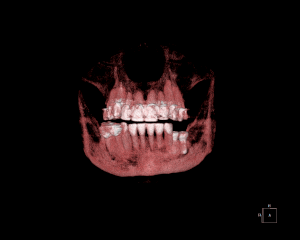For comment – a blog serves many purposes; increasingly as as social networking becomes part of the culture and fabric of dental education,it will provide literal 24/7/365 interaction on the part of the profession in all its multivariate components.
This case is very interesting with multiple facets. The recent extraction, planning CBCT’s, and implant placement images are attached. I first started treating this woman in 1987. The teeth I treated were as follows:
1987: #19 RCT – 3.6
1990: #20 RCT – 3.5
1996: #21 RCT – 3.4
1997: #29 RCT – 4.5
She moved to France for 10 years from about 1998 to 2008 during which time #’s 4, 5, 6, and 18 were treated (interestingly #’s 4 and 5 have now been extracted; #18 required retreatment, and #6 was the only success of those teeth treated in France). All the teeth I treated seem to be successful and functioning and I’ve taken recall CBCT’s as part of my personal long-term outcome study.
1987: #19 RCT – 3.6
1990: #20 RCT – 3.5
1996: #21 RCT – 3.4
1997: #29 RCT – 4.5
She moved to France for 10 years from about 1998 to 2008 during which time #’s 4, 5, 6, and 18 were treated (interestingly #’s 4 and 5 have now been extracted; #18 required retreatment, and #6 was the only success of those teeth treated in France). All the teeth I treated seem to be successful and functioning and I’ve taken recall CBCT’s as part of my personal long-term outcome study.
2009: #18 Retreatment RCT 2010: #14 RCT These are the most recent PA radiographs of these teeth (unremarkable except #14 to be discussed later)
She was difficult to treat then due to limited jaw opening and near impossible now 23 years later. The implant placements I performed yesterday were much easier than I had anticipated without teeth in the way. J This woman is super petite, arthritic, and has very limited jaw opening. (30 mm interincisal). I don’t usually do edentulous ridges because it typically isn’t an extension of an endodontic treatment plan, but I sometimes break the rules if the forces of push/shove and unusual circumstances dictate. It’s a loose guideline that I try to adhere to and the more I adhere to it the less chance I have of getting myself into trouble. I thought this one might have trouble written on it but it didn’t……lucky this time. I essentially got pushed into treating her implants because I’ve had such a long history with her and she trusts me.
The dentist initially wanted me to place 3 implants replacing the three teeth which were treated in n France and symptomatic. There wasn’t the space between the second molar and cuspid if I adhered to Tarnow’s spacing guidelines. The maxillary second molar had severe perio problems and was going to have to be extracted but I suggested keeping it a while as a posterior stop as the implants forward integrated, otherwise she’d be banging on the only molar she had on the left side (#14). The woman was complaining of nagging low level discomfort constantly in the area.
The patient didn’t want a bridge because she thought she was getting implants “instead” of a bridge. So we toyed with the idea of placing 3 implants shifted distally so there would be adequate room but the #4 replacement would essentially be in the former interproximal space and the occlusion/emergence/esthetics would be very odd. The referring dentist did a diagnostic wax up and agreed two implants and an implant supported bridge would be best. I couldn’t’ convince the referring dentist to keep the #2 tooth because of the


Image via Wikipedia
generalized discomfort in the area, so I went along with taking all four teeth out which I did in one visit. He made her a temporary RPD which had one clasp on the left side #14. As suspected she started complaining about sensitivity on #14. Eventually after a couple of months of escalating signs, symptoms, and constant complaining I treated #14 as well. I tended to regret extracting #2; it would have been a nice landmark for implant positioning and would have maintained the posterior ridge bone a little more predictably. I took #2 out at the same time because that’s what the patient and referring dentist wanted due to the discomfort in the area. I tried to lobby to save it longer but was unsuccessful.
Yesterday was the day of reckoning. I put her on oral Xanax (1 mg.) spray and stretched both sides of the head neck with Ethyl Chloride and placed them. I was very happy with the positioning. He primary stability was excellent and the virtual placement on the CBCT looks nearly identical to the actual placement with good parallelism. She’s still complaining about #14 being uncomfortable with her temporary RPD and biting, but we’re getting closer to the end.
Yesterday was the day of reckoning. I put her on oral Xanax (1 mg.) spray and stretched both sides of the head neck with Ethyl Chloride and placed them. I was very happy with the positioning. He primary stability was excellent and the virtual placement on the CBCT looks nearly identical to the actual placement with good parallelism. She’s still complaining about #14 being uncomfortable with her temporary RPD and biting, but we’re getting closer to the end.
















